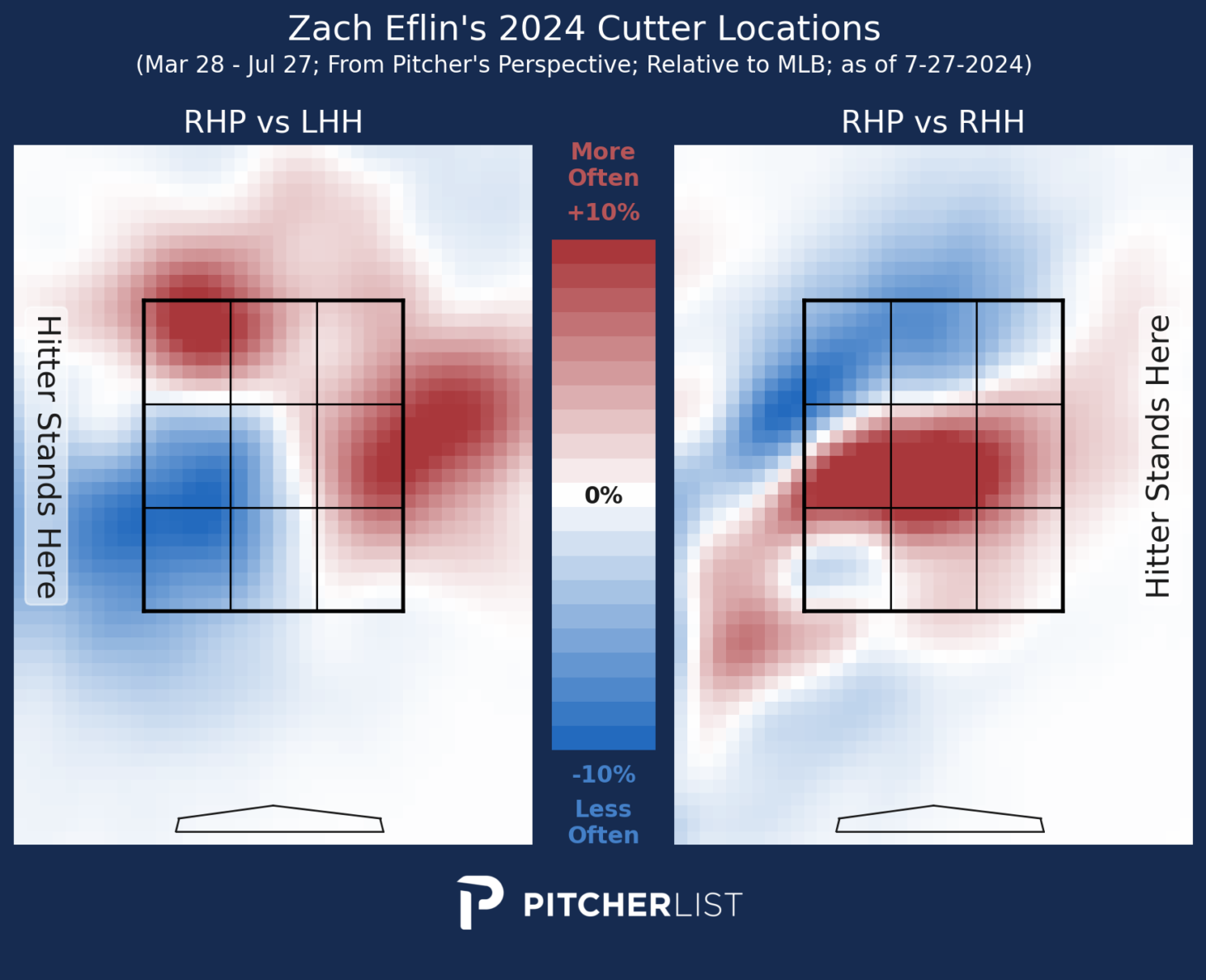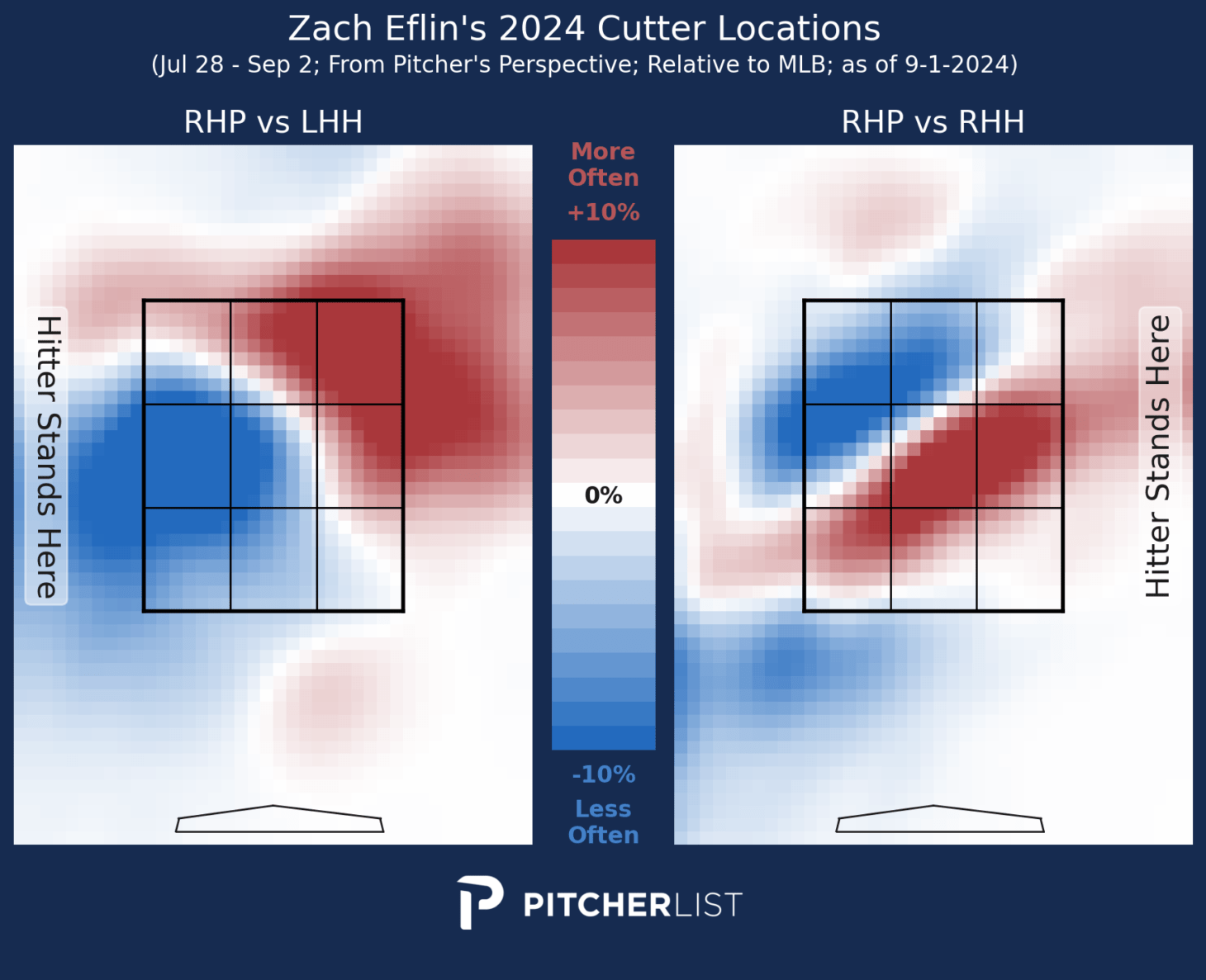We’ve seen many different versions of Zach Eflin over the nine seasons he’s spent in the big leagues. From leading with his 4-seam to almost shelving it entirely, picking up a sweeper and a cutter while leaving his first primary breaking ball behind. The man has been known to tinker in pursuit of better results. Now with the Orioles, he’s picked up a new trick. We’ll cover what he has to offer, then get into how this most recent change affects him.
The Arsenal
Eflin’s primary pitch is a heavy albeit somewhat slow sinker. Its velocity has not impeded its effectiveness, however. He racks up called strikes and induces ground balls with this pitch with no issue. The depth he creates from his release height is impressive and it runs enough to miss the barrel most of the time. It also has a good amount of seam-shifted wake contributing to its effectiveness. He likes to throw it front door to lefties, which is risky but with how well he pulls it off, it works. More often though, it’s down in the zone against righties. He especially likes to hit the glove-side corner with it, which is exactly where it should be. It’s not the most impressive primary fastball but it gets the job done and his command helps it play up.
As his sinker is better suited for same-handed hitters, his cutter takes over the primary role in platoon matchups. It’s what I would call a “traditional” cutter, in that it’s not a true fastball coming in a bit slower than those, but it’s not slow to the point of fitting more of a slider role. His usage of this pitch changed drastically recently, and that’s what we’ll be covering later. For now, just know that this is his new secret weapon.
Eflin’s curve isn’t a particularly interesting pitch having decent sweep and somewhat unimpressive depth for his release height. However, his ability to consistently locate it below the zone makes it a good offering as he gets chases to the tune of a 45.7% O-Sw%. That’s good enough for the 95th percentile. He’s had some bad luck with it this season with it sometimes getting hit well when it’s left in the zone but that should even out eventually.
In a vacuum, Eflin’s 4-seam is terrible. In the context of his arsenal, it works very well as a pitch that looks exactly like his sinker, until it doesn’t sink. He throws it out of the zone far more than most 4-seams and gets chases from unsuspecting hitters who think it’s a sinker or cutter. It helps that he’s got a knack for locating it very close but not quite in the zone. Even in this context it probably won’t ever rack up whiffs at an elite rate but the weak contact and whiffs he can get should be more than enough for a suitable fourth pitch.
His sweeper is a funky breaking ball that seems to be a tweak on his curveball. It starts at the same spin axis, with similar velocity and spin rate. Its spin activity sends it up the clock instead of down like the curve, making it drop less than hitters expect, especially if they guess it’s the curveball. He zones it constantly, forcing hitters to either take the strike or make largely worthless contact. They frequently hit it in the air due to how it functions, which is risky, but they usually don’t hit it very hard.
Like it has been for most of his career, Eflin’s changeup is mostly an afterthought. He’ll work it in against lefties sometimes and has the good sense and ability to just bury it low. He’s fishing for chases and off-balance swings from the surprise of the pitch and not much else. When it’s left in the zone it can get him into trouble but he doesn’t use it enough for that to be a real concern.
The Adjustment
As you’re likely aware, the Orioles employ one of the league’s foremost cut-fastball enthusiasts: Corbin Burnes. While he probably does it less than people would assume, you’ve probably seen a clip of him throwing a cutter that starts outside of the zone and then sneaks back in to catch the arm side edge. It’s a beautiful thing.
While that cutter is very different from Eflin’s, that doesn’t mean he can’t try the same thing, and try it he has. Since becoming an Oriole, Eflin has almost exclusively used his impressive command to throw back door cutters to lefties over and over again. He’s nearly abandoned the idea of throwing it in on their hands in favor of making them give up on it.
With The Rays

With The Orioles

Since being traded to the Orioles and using his cutter this way through his outing on September 1st, it ran an absurd 45.6% CSW%, compared to 27.3% with the Rays. Granted it’s a small sample of just 4 outings and 136 cutters but this change has substantially improved the results for a pitch he uses a lot against opposite-handed hitters. He seems to have already solved the platoon problems he had earlier in his career, so while this change may not have been necessary, I’m not going to argue with the improvement he’s seen as a result of it. He has scaled back this relentless usage of the cutter on the arm side against lefties a bit in his last two outings, but his cutter usage overall has risen. It’s probably a good thing that he’s already made the necessary adjustments to avoid becoming predictable with it.
The Outlook
Going forward, I think it’s safe to expect a lot of the same from Eflin. He’s going to refuse to walk hitters by filling the zone and getting chases when he ventures out of it. He’s going to run around league-average strikeout rates with his deceptive and creative arsenal being used to his strategic advantage. He’s going to manage contact as best he can with what he has to offer. That’s just who he is. He’s a relic of a different era of baseball, where more than just the highest of pitchability types could survive without great stuff. That isn’t to say he’s not a good pitcher, he’s seen a lot of success in recent years. He just doesn’t fit the modern model of overwhelming stuff from seemingly every pitcher who takes the mound now. While health is a different conversation, when he’s going out there he’s a reliable arm that you can usually trust to pitch well.
I’m fascinated to see if he continues doing this with his cutter. He curveballed the Rockies into submission at Coors Field in his return so we didn’t get to see as much of his cutter as normal. Then his cutter was his most used pitch in his next two outings. It’s something to keep an eye on. I imagine hitters will catch onto it eventually at which point he’ll adjust again, like he always does.
